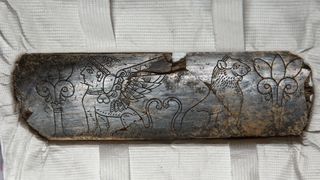2,800-year-old ivory carved with sphinx discovered in Turkey
The artifact is from an Iron Age settlement at Hattusa that was established after the city was abandoned by the Hittites.

Archaeologists in Turkey have unearthed an ornately carved 2,800-year-old elephant tusk in what may have once been an Iron Age “center of power.”
The ivory carving features a mythical sphinx — a human head on the body of a winged lion — as well as a depiction of a real lion and two tall plants that may represent the mythical “tree of life.” While the artwork dates to the Iron Age, it was found in an archaeological layer over a much older city — the deserted Bronze Age Hittite capital of Hattusa.
According to Andreas Schachner, an archaeologist with the German Archaeological Institute who has led excavations at Hattusa since 2006, the artifact shows that the Iron Age settlement at the site was an important place, although it was established after the Hittites had abandoned the city in about 1200 B.C., during what’s known as the Late Bronze Age collapse.
 The artifact was found in a soil layer from an Iron Age settlement, which sat on top of the Bronze Age Hittite city of Hattusa. (Image credit: Anadolu Agency via Getty Images)
The artifact was found in a soil layer from an Iron Age settlement, which sat on top of the Bronze Age Hittite city of Hattusa. (Image credit: Anadolu Agency via Getty Images)
“It is possible to say that this place was no longer a small town but a more important place, perhaps a center of power,” Schachner told the Turkish state-owned Anadolu Agency.
Related: Enigmatic Anglo-Saxon ivory rings discovered in elite burials came from African elephants 4,000 miles away
The artifact is about 12 inches (30 centimeters) long and 4 inches (10 cm) wide, and Schachner said it may have been part of a piece of furniture.
“It was probably added as an ornament to a wooden box or furniture made of wood in its own time,” he told the agency. “The work is broken on the right and left sides, and the upper and lower sides are in our original form. Therefore, it is possible to guess that it was longer.”
Iron Age settlement
 The ivory is carved with depictions of a mythical sphinx and a lion, along with two tall plants that may represent the mythical “tree of life.” (Image credit: Anadolu Agency via Getty Images)
The ivory is carved with depictions of a mythical sphinx and a lion, along with two tall plants that may represent the mythical “tree of life.” (Image credit: Anadolu Agency via Getty Images)
Schachner explained that the object was unique among finds at the Iron Age settlement built at the abandoned Hattusa site, which is now beside the Turkish village of Boğazköy (also spelled Boğazkale), about 90 miles (145 kilometers) east of Ankara.
“For the first time, we are faced with a work decorated with such a dense, beautifully rendered scene,” he said. “Extensive excavations have been carried out at the Iron Age levels at Boğazköy, but we had not come across such a detailed artifact before.”
He added that the symbols carved into the fragment might reveal relationships between the settlement and other contemporaneous cultures.
After scientific studies of the ivory carving are complete, it will go on display at the Boğazköy Museum, Schachner said.
Related Post
A shocking documentary proves that mermaids do exist
SHOCKING Revelation: Thuya, Mother of Queen Tiye, Was the Grandmother of Akhenaten and Tutankhamun—What Ancient Egyptian Secrets Did She Leave Behind?
Breaking News: Astonishing Discoveries at Karahan Tepe Confirm an Extraterrestrial Civilization is Hiding on Earth, and NO ONE Knows!
Breaking News: Researchers FINALLY Discover U.S. Navy Flight 19 After 75 Years Lost in the Bermuda Triangle!
NASA’s Secret Investigation: Uncovering the Astonishing Mystery of the UFO Crash on the Mountain!
Explosive UFO Docs LEAKED: Startling Proof That Aliens Ruled Ancient Egypt!